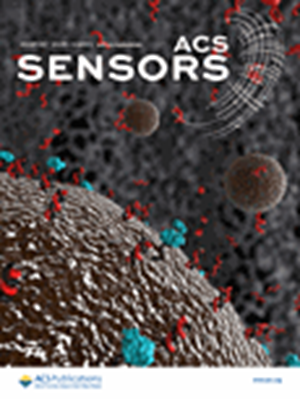使用特定呼吸挥发性有机化合物准确诊断阿尔茨海默病
IF 9.1
1区 化学
Q1 CHEMISTRY, ANALYTICAL
引用次数: 0
摘要
呼气中的挥发性有机化合物(VOCs)是否可以作为阿尔茨海默病(AD)诊断的一种新的生物标志物尚不清楚。为了确定AD中显著不同的VOCs,共招募了970名参与者,包括数据集1中的60名个体(AD, 30;对照组,30人),数据集2 164人(AD, 82人;对照组,82人),数据集3中637人(AD, 31人;对照组,606人),数据集4中的109人(额颞叶痴呆,19人;血管性痴呆,21岁;帕金森病,69)。数据集1、2和4的参与者来自中南大学湘雅医院。数据集3的参与者来自一个为期两年的随访队列。检测呼吸和血浆中的VOCs、神经心理学评分、血浆p-tau181水平、血浆代谢物和脑功能连通性。我们在数据集1中发现两组间有6种VOCs存在显著差异,并在数据集2和数据集3中得到验证。乙醇(m/z = 46)和吡咯(m/z = 67)在数据集1和2(临床数据集)中的AUC分别为0.907和0.895,在数据集3(社区数据集)中的AUC分别为0.849和0.974。神经心理测试显示,六种挥发性有机化合物与认知能力下降有关;其中5种与血浆p-tau181相关,这5种血浆挥发性有机化合物一致地改变为呼吸挥发性有机化合物。血浆中代谢物与5种挥发性有机化合物存在相关性,这5种挥发性有机化合物可能来源于血液代谢物。此外,四种呼吸挥发性有机化合物与大脑连通性的改变有关。综上所述,特定呼吸挥发性有机化合物可作为AD检测的生物标志物。本文章由计算机程序翻译,如有差异,请以英文原文为准。

Accurate Diagnosis of Alzheimer’s Disease Using Specific Breath Volatile Organic Compounds
Whether volatile organic compounds (VOCs) from exhaled breath can be used as a novel biomarker for Alzheimer’s disease (AD) diagnosis is unclear. To determine the significantly distinctive VOCs for AD, a total of 970 participants were enrolled, including 60 individuals in data set 1 (AD, 30; controls, 30), 164 individuals in data set 2 (AD, 82; controls, 82), 637 individuals in data set 3 (AD, 31; controls, 606), and 109 individuals in data set 4 (frontotemporal dementia, 19; vascular dementia, 21; Parkinson’s disease, 69). The participants in data sets 1, 2, and 4 were from Xiangya Hospital, Central South University. Participants in data set 3 were from a two-year follow-up cohort. VOCs in breath and plasma, neuropsychological scores, plasma p-tau181 levels, metabolites in plasma, and brain functional connectivity were detected. We found that six VOCs were significantly different between the two groups in data set 1 and were verified in data set 2 and data set 3. Ethanol (m/z = 46) and pyrrole (m/z = 67) presented AUC values of 0.907 and 0.895 in data sets 1 and 2 (clinical data sets) and 0.849 and 0.974 in data set 3 (community data set), respectively. The six VOCs were associated with cognitive decline as reflected by neuropsychological tests; five of them were correlated with plasma p-tau181, and these five plasma VOCs were consistently altered as breath VOCs. Correlation between metabolites and five VOCs in plasma was noted, and the five VOCs may originate from blood metabolites. Moreover, four breath VOCs were associated with altered brain connectivity. In conclusion, specific breath VOCs may be used as biomarkers for AD detection.
求助全文
通过发布文献求助,成功后即可免费获取论文全文。
去求助
来源期刊

ACS Sensors
Chemical Engineering-Bioengineering
CiteScore
14.50
自引率
3.40%
发文量
372
期刊介绍:
ACS Sensors is a peer-reviewed research journal that focuses on the dissemination of new and original knowledge in the field of sensor science, particularly those that selectively sense chemical or biological species or processes. The journal covers a broad range of topics, including but not limited to biosensors, chemical sensors, gas sensors, intracellular sensors, single molecule sensors, cell chips, and microfluidic devices. It aims to publish articles that address conceptual advances in sensing technology applicable to various types of analytes or application papers that report on the use of existing sensing concepts in new ways or for new analytes.
 求助内容:
求助内容: 应助结果提醒方式:
应助结果提醒方式:


